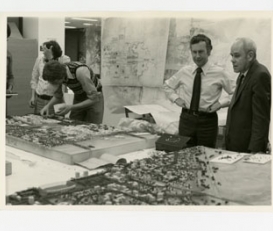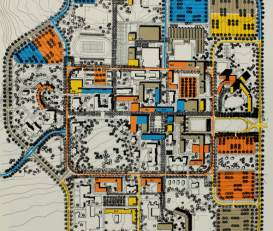
Macklin Hancock was born in Nanjing, China, in a hospital founded and built by his grandfather. He grew up, however, in Canada: the Hancock family returned home in 1928, during China’s Nationalist Revolution.
Like many of Canada’s early pioneers, Macklin was immersed in horticulture as a child. His father, Marcus Leslie Hancock, was a professor of horticulture, first in China and then in Guelph at his alma mater, the Ontario Agricultural College. Marcus then established Woodland Nursery near Toronto, and in his later years, donated his remarkable rhododendron collection to Montreal’s Botanical Garden. The rhododendron garden there – and also one at the University of Guelph – both bear his name.
Macklin, too, would earn a degree in horticulture at Guelph, but during World War II, he enlisted in Canada’s military where he piloted Spitfire aircraft until the war ended. In the post-war years, he pursued landscape architecture at Harvard, and remarkably, while still a student began the commission that would at once become his Harvard thesis, and establish his reputation: preparing the master plan for the community of Don Mills.
Toronto developer E.P. Taylor, who had acquired 835 hectares of land between two branches of the Don River, envisioned a community of 35,000 on the site. Taylor and company president Karl Fraser, Hancock’s father-in-law, engaged the 27-year-old Hancock to design it. The masterplan would ultimately gain international recognition for its clearly defined town centre, its neighbourhoods of modernist housing on wide lots, its curving streets and traffic-calming cul-de-sacs. Keeping business services to the peripheries, “Mack” designed a revolutionary system of parks and open spaces linked by trails, inviting the community to the town’s river valleys and ravines. Don Mills quickly became a much-studied model of town planning.
In 1956, Hancock became the President and founding member of Project Planning Associates Limited, an integrated consulting practice which took on hundreds of projects over five decades. Project teams included landscape architects, planners and engineers – and later, environmental and socioeconomic specialists, working on such diverse Canadian projects as Expo67, Ontario Place, Meadowvale New Town, and the City of Westminster. PPA took on scores of international projects: in Arabia (King Abdul University), in Nigeria’s capital Abuja, in Russia’s St. Petersburg, in China’s City of Xi’an, and dozens more.
Macklin Hancock served as President of the OALA and the Canadian Institute of Planners, and received many honours, including a CSLA Lifetime Achievement Award and the Order of Ontario. In 1997, the Ontario Heritage Foundation designated Don Mills a heritage site.
For short descriptions of selected projects, see The Cultural Landscape Foundation’s website.
Lead photo: Macklin Hancock, c.1965. Courtesy Cecelia Paine
2 Macklin Hancock (no credit)
3 Macklin Hancock. Project Planning Associates Ltd. Fonds. University of Guelph.
4 Photo Toronto Public Library.
5 1964: Long Range Development Plan and Master Plan, University of Guelph, Project Planning Associates Limited. IMAGE/ Courtesy of Owen Scott and OALA



